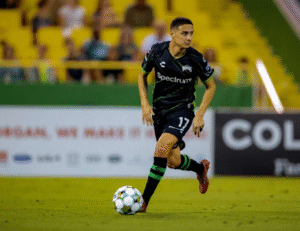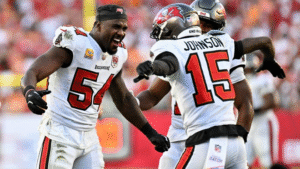Bucs Draft Needs: Tight Ends

The NFL draft is quickly approaching, and as the combine winds down it’s time to start preparing for whom the Tampa Bay Buccaneers will announce as their selections on that stage at Lambeau Field. To simplify this process, I’ve ranked seven of the Bucs needs:
- OLB
- DE
- ILB
- CB
- OG
- TE
- S
This week we are moving on to Tight Ends. While the position group is certainly good enough going into 2024, Cade Otton is set to enter free agency after next year, and if the second half of the 2024 season is any indication, Otton could be in for a big payday. While Payne Durham has been a good blocker, Devin Culp is still a bit of an unknown. It would certainly be nice if the Bucs could spend a day 3 pick on the position and add talent to the room, with hopes of finding a player to replace Otton in 2026.
Rather than just listing drills and a bunch of numbers, I’ll be using the RAS system, created by Kent Lee Platte (@mathbomb and @mathbomb.bsky.social on Twitter and Bluesky). RAS, or Relative Athletic Score is a composite scale that factors height, weight, speed, and agility drills to spit out one number that can be viewed as a percentile. For example, QB Mac Jones had a RAS of 7.15, meaning he is just below the 72nd percentile for physical traits among QBs, while former WR Calvin Johnson’s 2007 combine and Anthony Richardson’s 2023 combine scored them a perfect 10.00 for their respective positions.
Until pro days start, I’ll be using combine measurements as well as available film to break down each prospect, which means if they didn’t test certain drills at the combine, their RAS may be incomplete.
So what should the Bucs be looking for in a Tight End? Durham and Otton are by no means elite run blockers. Durham is pretty good as a pass blocker, but Otton is nothing special in that regard. Neither are anywhere near elite receivers either, but Otton is good enough within the offense with so many other weapons. In my humble opinion, they should be looking for a tight end whose skill set tends more towards receiving, and they could especially use an extra red zone threat.
This is by no means a terribly deep position in this draft, so it’s entirely possible the Bucs miss out on all of these prospects while drafting more needy positions like defensive back or linebacker. That being said, here are a few of my favorites from the top of the cohort.
PSU Tyler Warren
6’5” 4/8 256 lbs
RAS: ???
Warren has yet to test at the combine or a Pro Day as of writing this, but I would guess he tests about as well as any Tight End could. Warren has all the hallmarks of a true ball player. Gritty, hard nosed, physical football is more than a brand for Warren, it’s the lifestyle. Pair that with the versatile packages and uses Penn State found for him, and you have a very intriguing prospect. His incredible size will immediately translate to the big leagues, but his speed and his change of direction will likely limit his route tree and his run after the catch. However, his ability to shed tackles is frankly overlooked, and I’m curious to see if the swiss army knife usage translates to the NFL.
Fit Grade: A
UMICH Colston Loveland
6’5” 6/8 248 lbs
RAS:???
Loveland excites me quite a bit but there are some major question marks that I think may hold him out of the first round. Let’s start with the pros. The athleticism jumps out of the screen at you. I don’t know that I’ve ever seen a Tight End move the way Loveland does in the open field. His routes are crisp and his movement is very technically sound. The major questions arise when you look at his size. Loveland is a little on the lean side, and his frame certainly doesn’t look like that of a Tight End on film. This primarily shows up in his run blocking tape. He struggles against defensive lineman at the college level and it will be a glaring issue until he can pack on the pounds to hold his own. That being said, there are plenty of teams that don’t use in-line Tight Ends at a high rate, but unfortunately Tampa Bay does.
Fit Grade: B+
UM Elijah Arroyo
6’5” ⅛ 250 lbs
Bench: 22 reps
RAS:???
Arroyo is a pure receiving threat. Don’t let his size deceive you: he is not a good run blocker. Arroyo will make his money at the next level as a dependable, Quarterbacks best friend type of player. After all, he only had 1 drop last season despite his 50 catch volume. He’s an above average athlete for the position with sneaky good run after the catch ability, and his ability to be a downfield threat will be vital for him to stay on the field at the next level. You just have to hope his blocking technique gets cleaned up. His best traits at the next level will be his toughness and willingness to put in the work.
Fit Grade: C
LSU Mason Taylor
6’5” ⅛ 251 lbs
RAS:???
Taylor will probably not be a major contributor in his rookie season, but that’s ok. His development may take a season or two, but Taylor has a lot of potential. The sure-handed LSU Tiger had hardly any drops and plenty of contested catches. His reliability will keep on the field, but his lack of explosive athleticism will have to be made up in other ways. His blocking technique is good enough, but he will also need to hit the weight room, just like every Tight End here. For now, he remains nearly a pure receiving threat with plenty of upside.
Fit Grade: B-
ORE Terrance Ferguson
6’5” ⅜ 247
40 yard dash: 4.63s
Vertical: 39in
RAS: 9.84
For someone his size, Ferguson is an interesting outlier in multiple ways. He’s not a terrifically impressive blocker, and he doesn’t necessarily play like a contested catch threat. But he’s exciting everywhere else. He’s about as athletic as can be for a Tight End. He also played a lot more slot than in-line partially because, as mentioned, he doesn’t have the run blocking ability you would expect from his size. If he can improve on those skills in the near future, expect big things from Ferguson.
Fit Grade: C+
BGSU Harold Fannin Jr.
6’3” 2/8 241 lbs
40 yard dash: 4.71s
Bench: 22 reps
3-cone: 6.97
RAS: 7.65
Harold Fannin Jr. is one of those players that make you wonder what it must be like to root for a Group of 4 school and see one of the best players in your school’s history be graded as like a fourth round pick. Fannin Jr. finished the season as Bowling Green State University’s tenth all time leading receiver with just two years as a full time starter. He led FBS in both catches (117) and yards (1555), with ten receiving touchdowns. He also tacked on an extra 9 carries for 65 yards and a touchdown, which comes nowhere close to his Freshman rushing total of 10 carries for 53 yards and four touchdowns. All jokes aside, Fannin Jr. is as productive as they come. He’s a true threat with the ball in his hands, as he led all Tight Ends in missed tackles forced with 34 (!!!). He reached a catch rate over 90% in all three of his seasons, and his blocking reps are about as good as they get at the college level. And for those that complain that he played nobodies in the Mid-America Conference, he graded at 89+ on PFF in back to back games against Penn State and Texas A&M. His size is absolutely a concern but the Bucs have shown no qualms about drafting undersized TE’s, given they picked Devin Culp last year, who is nearly identical in size. If Fannin Jr. is at all available for the Bucs, I’m absolutely fine with spending a third round pick on Fannin Jr.
Fit Grade: A+
While this is not the most important or valuable position, an elite Tight End can take good or even great offenses to an absolutely elite level, opening up underneath passing lanes and providing versatility to spread linebackers thin. With as many needs as the Bucs have on the other side of the ball, don’t expect a Tight End to be picked in the first two days of the draft, but this remains to be their biggest need on that side of the ball outside of offensive line depth. While Jason Licht doesn’t have the best track record drafting Tight Ends (including trading up for a certain Alabama prospect), I wouldn’t expect a Surprise Gunnar Helm Round One 19th Overall Pick.







